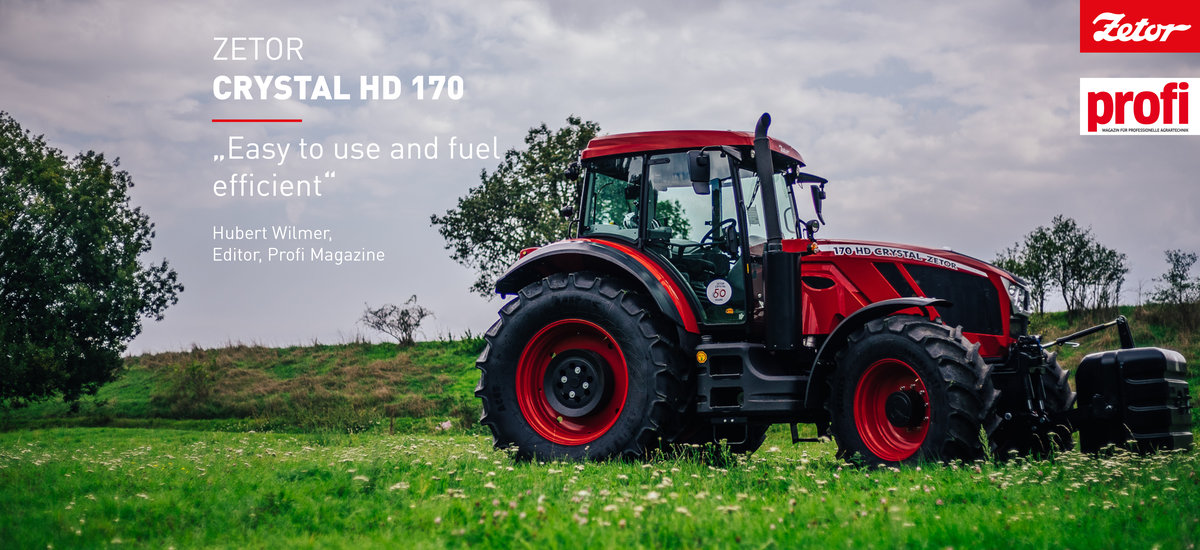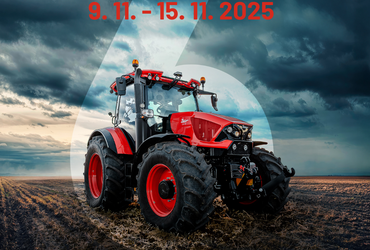- About Tractors
- 22.6.2020
ZETOR CRYSTAL HD 170 shined in the Profi Magazine
Přihlášení

The international independent magazine Profi International chose our ZETOR CRYSTAL HD 170 for its testing. The test results were published in its English and German versions, and as the editors themselves stated, it was a real surprise! Read an exclusive expert review of our flagship model and see for yourself the power of our Hardworker, who will soon be launched in an innovated version.
Earlier this year Zetor unveiled the new generation Crystal at LAMMA. We put the flagship 170 HD model through our profi test, to see whether the mix of in-house and bought-in components works.
Its predecessor model the Crystal 160 may not have been the sales succes Zetor had hoped for the UK and Ireland but the all new 170 HD is now overcoming those slow early days. In just a few moths a number of units have already been retalled and a demo tractor is soon destined to arrive to give things a further boost for the 40 dealers spread across the UK and Ireland.
First surprise is when you open the bonnet to reveal a six-pot Deutz TCD 6,1 L6 motor. This is the same engine that Fendt uses its 700 series tractor. In the Zetor it is just as quiet, offers the same impressive responsiveness with plenty of grunt in the field and on-farm experience we packed our test machine off to the DLG to see how it would perform on the bench.
The Crystal 170 HD delivers a maximum engine power of 120 kW/163 hp(to ECE-R 24, so with all the ancillaries in place), according to the brochure sper sheet, which also states a pto output of 101,6 kw/136,2 hp. On the DLG dyno, the Zetor mustered a maximum output of 107,0 kW/143,5 hp at the shaft with the motor hanging on at 1 700 rpm. Excellent. Output at a rated speed of 2100 rpm was excactly 94,1 Kw/126,2 HP. This works out at nearly 14 % extra power and a constant power range of more than 35 %. These stats and a torquerise of almost 56 % as speed drops by almost 33 % along with a 137 % drive-off torque, are all very good returns and gave us a new experience from a Deutz engine.
More praise goes to fuel economy, which at maximum pto output is a frugal 237 g/kWH. This place the Crystal in a leading position among low-consumption tractors. And this economy isn´t tainted by the 10,6 g/Wh of AdBlue needed to feed Stage IV compliant engine. While we are on the subject of AdBlue, the 30 litre Diesel Exhaust Fluid tank resides on the left-hand side as per the norm, whereas the 300 litre fuel tank is found on the right. You will notice we haven´t included a Power-mix result for a conclusive assessment of the Crystal´s fuel economy. Unfortunately, while on the DLG test bed the clutch failed in our tractor, and it couldn´t be repaired quickly enough to continue testing. We hope to repeat the test again and publish the results in a future issue.
Before we get to the transmission, we would like to mention the two speed memories. These are easy to set up and activate, but the downside is that they are automatically disabled when the operator presses the clutch. Zetor says this is to reduce wear on the clutch, but we found in not very practical.
The transmission in essentially the same box we tested within Forterra 150 HD in the 09/2016 issue. There are two ranges, five gears and three powershifts, which add up 30 forward and 30 reverse speed with 12 of them in the main field work band albeit spread across the two ranges. The reverse doubled-H-shift pattern takes some getting used to as does activating the auto power-shift function. The button for this is located too far back on the side console.
Speed matching is only available when the auto-shifting is activated so the powershift automatically shifts during a gear change. On a positive note we liked the powershuttle and what Zetor dubs Eco 40 allowing the Crystal to hit 40 km/hr at a fuel-saving 1700 rpm. Good stuff, although it´s worth noting that there´s no 50 km/hr option on the Zetor.
Pto specification scores well with four speeds (540, 540 E, 1000 and 1000 E) as a standard. If you go with the ground speed option (not currently offered in the UK), the pto tally drops to just two – 540 and 1000. The only details that could do with improving in the pto department are the decals for the switch used to change between 540 and 1000 and the lever that operates the cable for „normal“ and „eco“ speeds. There are no such identification issues with the tractor´s ecternal pto controls on both mudguards.
Moving on the hydraulic system and linkage, we get the bad news out of the way first. The Crystal only has a gear pump with no option to upgrade to a swash plate unit. The constant flow produced 81,3 l/min at the couplers when tested by DLG. This is on the low side for a tractor in this power band; ideally you´d be wanting to see an output of over 100 l/min. Spool count is four (plus one) double-acting-fine, though one of these is occupied by the frint linkage if fitted.
Our test tractor had a factory-fit-front linkage, which is supplied by Zuidberg and delivers a healthy 3100 kg of lift power. Annoyingly the linkage cannot be activated externally and the arms only lower down to 30 cm off the ground. You also need to open the bonnet before you can remove the top link.
Going back to the spool valves, these are well specced with a cross controller (whis is a bit too much of a reach) with a time and flow functions. Separate dials make adjustments nice a simple, and if they were to gain a scale it would be spot on.
The rear linkage uses two assistor rams. The link arms developed a continuous lift power of 6582daN, which is more than enough to lift a 3,7 t one-pass dril. So, overal, good. Functional but not exactly stylish is the Bosch ELC panel. There is a risk of inadvertenly resetting the position control as you reach for the quick lift/lower controller. The other dials for lift height, drop rate etc are also very close neighbours.
The CBN Cat III couplers performer faultlessly, while the basic top link is fine. We would strongly advised going with the optional automatic CBM stabiliser. More recommendable options latter…
Now on the cab, which has mechanical suspension as standard. The wide steps could do with some beefing up and better protection from filling with mud. There is also a right-hand door, but the steps are vertical as they are in corporated into the plastic diesel tank. All-round visibility is good for a six-post cab. A major good dampener is the dark headlining in the low roof, which spoils the sense of space. The sun blind is also a bit shoddy and detracts from the rest of the build quality. Other wise there are no gripes with storage room, although a coolbox wouldn´t go amiss on hot summer days.
Cool air is supplied by a three-speed fan, and there are just the five outlets in the roof. But we can deal with that; however, the standard air-conditioning system ran out of chill once outside temperatures climbed above 25 C. Otherwise we really appreciated the low noise level inside the cab, especially when doing road work. We were very surprised by the DLG´s lab result, which measured as high as 79,5 dB(A) at full load.
On to night time work, and you can have up to six optional LED work lights and, ideal for road work, two beacons. And if you need and ISObus system, this can be purchased from the factory as a retrofit kit. The same applied to the GPS steering. Handily, the Crystal keeps all of the performance information on the dash, which has a useful display…but there is no clock.
To complement the cab suspension Zetor has opted for the Carraro front axle with independent suspension, which gives excellent operator comfort. Downside as always with this unit are the 25 grease nipples, so it´s well worth opting for the automatic lubrication system. That´s our view, anyway.
Maximum rear rubber in the 170 HD is 650/65 R38. There is no R42 option. Up front you can go with 540/65 R28, which on a 1,94m track width allowed our test tractor to turn through a 12.80 m radius, not least thanks to the pivoting front mudguards. Excellent.
What is also impressive about the Zetor is the new air brake support. The brake pedal modulates with ease, and deceleration was a very impressive 5,5 m/s² as measured by the DLG. Add to this the accomulated handbrake and you end up with a top stopping package.
Weighing in a just under 6,5 t, the test spec Crystal 170 HD (without wheel weights) was no heavier than mosts other four-cyl tractors in this power band. But the gross weight is just 10 000 kg, meaning the user has to make to with a modest payload of just 3 450 kg.
Summary: The Zetor Crystal 170 HD surprised us in every respect. The Deutz engine delivered excellent results at the DLG and made a pleasure to use. Also in terms of comfort and quiet running, the test tractor with standard front axle suspension delivered similarly top-class results. Add to this good lift power, as well as the time-and flow-controlled spools. One of the details that doesn´t fit in the good spec picture is the gear pump in the hydraulic system, which produced a humble 80l/min. There are a few other compromises with the likes of the three powershifts, the 3,4 pay load and weak ventilation system.
Zetor Crystal HD 170 powermix results
In the September 2019 issue we tested the Zetor Crystal 170HD, but at the time we were unable to bring you the Powermix results. Since then the Crystal has been through its paces on the DLG rolling road and dyno. Here the results.
We were certainly suprised by the performance of the Crystal 170 HD last year, but some questions were left unanswered due to a clutch failure when on the dyno. With the tractor back up and running we have been able to complete the Powermix tests which back up or gut instinct.
The largely mechanical transmission comes into its own when doing heady draft work such aas pulling a plough or cultivator. Here the fuel consumption rate dropped to 5,0 % below our average rate for the test group. Even on heavy pto work the Zetor´s diesel use reamins in the mid-field in all od the test runs.
A surprise are the results from the mixed work category which includes hydraulic work, such as spreading muck or baling. Although the Crystal has a gear pump for the hydraulics the tractor is still very frugal. In fact, specific consumption was around 6,0 % less than the average rate of all the tractor tested up to now. That´s very good.
The 170HD is equally thrifty when on the road. Reaching its maximum speed of 40 km/hr at a low 1700 rpm, the specific consumption was 387 g/kWh, which is nearly 7,0 % less than the average rate.
Source: edited from the review of ZETOR CRYSTAL HD 170 from Hubert Wilmer/Mervyn Bailey | Profi 8-2019, Profi 4-2020.


